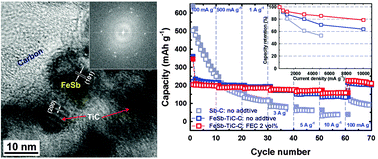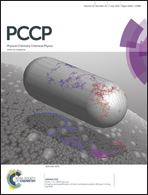High-performance FeSb–TiC–C nanocomposite anodes for sodium-ion batteries
Abstract
Antimony-based alloy anodes with a Fe metal support dispersed in a conductive matrix consisting of TiC and carbon have been developed by high energy mechanical milling (HEMM) for sodium-ion batteries. The samples have been characterized by X-ray diffraction before and after sodiation at different C rates and by high-resolution transmission electron microscopy before and after cycling for 100 cycles. Electrochemical charge–discharge cycling at various rates and electrochemical impedance spectroscopy measurements have been carried out with and without 2 vol% of the fluoroethylene carbonate (FEC) additive in the electrolyte. With well-defined crystalline FeSb and TiC structures, the FeSb–TiC–C nanocomposite anodes demonstrate superior rate capability with good capacity retention at 10 000 mA g−1 for sodium-ion storage, which could be ascribed to the novel nanocomposite structure consisting of a good metal (Fe) framework and a combination of conductive TiC and carbon as a matrix. The FEC additive particularly leads to a longer cycle life with high rate capability due to the formation of a stable, thin SEI layer and a smaller charge-transfer resistance.


 Please wait while we load your content...
Please wait while we load your content...